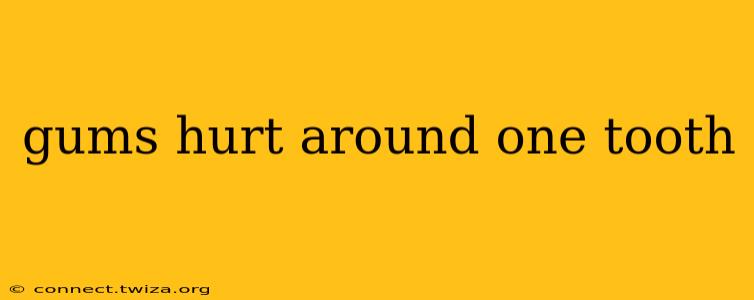Experiencing gum pain localized around a single tooth can be unsettling. It's a common dental problem with various potential underlying causes, ranging from minor irritations to more serious infections. Understanding the possible reasons for this pain is crucial for effective treatment and preventing further complications. This comprehensive guide will explore the common culprits behind localized gum pain and offer insights into seeking appropriate dental care.
What Could Be Causing Gum Pain Around One Tooth?
This is often the first question people ask when facing this problem. Let's break down some of the most frequent causes:
1. Gingivitis or Periodontitis (Gum Disease):
Gingivitis, the early stage of gum disease, is characterized by inflammation and redness of the gums. Periodontitis, the advanced stage, involves the destruction of the supporting tissues and bone around the teeth. Localized gum pain around one tooth can be a sign of either condition, particularly if accompanied by bleeding gums, swelling, or pus. Good oral hygiene practices, including regular brushing and flossing, are crucial in preventing and managing gum disease.
2. Abscess (Infection):
A gum abscess is a localized collection of pus caused by a bacterial infection. This infection can stem from deep pockets of gum disease, decay beneath a filling, or trauma to the gum tissue. Symptoms include severe, throbbing pain, swelling, and redness around the affected tooth. An abscess requires prompt professional dental treatment to prevent the spread of infection.
3. Tooth Decay (Cavities):
Untreated tooth decay can lead to infection, causing inflammation and pain in the surrounding gums. The decay may not always be visible, making a dental examination crucial for accurate diagnosis.
4. Food Impaction:
A piece of food lodged between teeth or under the gum line can irritate the gum tissue, causing localized pain and inflammation. Careful flossing and rinsing can often resolve this issue.
5. Damaged or Irritated Gum Tissue:
Trauma to the gums, perhaps from biting your cheek or accidentally injuring the gum with a toothbrush, can cause localized pain and inflammation. This usually resolves on its own within a few days.
6. Orthodontic Appliances:
If you wear braces or other orthodontic appliances, they can sometimes irritate the gums, leading to localized pain. Adjustments by your orthodontist may be necessary.
7. Grinding or Clenching Teeth (Bruxism):
Excessive grinding or clenching of teeth can put pressure on the gums, leading to soreness and discomfort around one or more teeth. A night guard may be recommended to alleviate this.
How to Treat Gum Pain Around One Tooth?
The appropriate treatment depends entirely on the underlying cause. Self-treating is rarely recommended. See a dentist as soon as possible if you experience:
- Severe pain: This often indicates a more serious problem like an abscess.
- Swelling: Significant swelling could signify an infection.
- Bleeding gums: Persistent bleeding suggests gingivitis or periodontitis.
- Pus: Pus is a clear indication of an infection.
Your dentist will conduct a thorough examination, take x-rays if necessary, and diagnose the problem. Treatment options may include:
- Scaling and root planing (deep cleaning): For gum disease.
- Antibiotics: For bacterial infections like abscesses.
- Root canal treatment: For severe tooth decay.
- Extraction: In some cases of severe infection or damage.
- Pain medication: For pain relief.
When Should I See a Dentist?
Don't delay seeking professional dental care if your gum pain is severe, persistent, accompanied by swelling or pus, or if you notice any other concerning symptoms. Early intervention can often prevent more serious complications and preserve your oral health.
This information is for general knowledge and does not constitute medical advice. Always consult with a qualified dentist for diagnosis and treatment of any dental problem.
